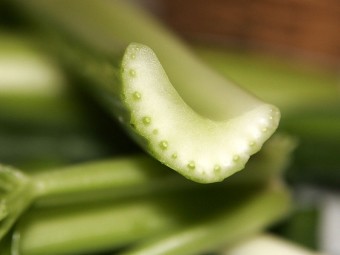There is No Such Thing as a Negative Calorie Food
 Myth: Your body uses more calories to digest certain types of foods, called “negative calorie” foods, than the actual calories contained in them.
Myth: Your body uses more calories to digest certain types of foods, called “negative calorie” foods, than the actual calories contained in them.
The concept of negative calorie food has recently been popularized by the media, around on Internet discussion boards, and from publications, such as “Foods that Cause You to Lose Weight: The Negative Calorie Effect“, by Neal D. Barnard. In this so called “negative calorie diet”, it is believed that there are certain foods, such as celery, broccoli, papaya, and lettuce, where the amount of energy used to digest the foods is greater than the amount of energy provided by the foods. More technically, that the Thermic effect is greater than the food energy content.
Unfortunately, like so many other gimmicky diets, this is just too good to be true and currently there is zero scientific evidence that there are any foods that are actually “negative calorie”. In fact, the digestive process typically only accounts for around 10% of most caloric in-take. With the so called “negative calorie” foods, this number tends to jump to around 20%-30%, but not always, sometimes it stays around the standard 10%. Even in the extreme case, unfortunately, “20%-30%” is not greater than 100%.
For a specific example, arguably the most popularly touted “negative calorie food”, celery, tends to contain around 6 calories per medium sized piece, but only actually takes around 1/2 a calorie to digest that piece, so around 8% of the caloric in-take is “lost”, not 100+%. That’s not to say celery isn’t a great food to eat (it very much is for a variety of reasons), but it’s not even close to “negative calorie”.
Even knowing that “negative calorie” food is one of many dieting myths, you still can benefit from including more vegetables and fruits in the everyday menu as they are naturally low in calories and have vitamins, minerals, anti-oxidants, and phytochemicals. Further, the specific fruits and vegetables often touted as “negative calorie” foods typically are very low in calories, so often make great snacks and meals.
Bonus Facts:
- In 2007 Coca-Cola and Nestle had to pay a $650,000 fine for saying their green tea drink, Enviga, burned 20 – 33 calories more than it delivered in a 12-ounce can. The FDA didn’t find any scientific evidence to support this claim and so subsequently fined them.
- The ‘calorie’ was first defined by Nicolas Clément in 1824 as a unit of heat. In most fields, its use has been replaced by the ‘joule’. Today in many countries, like the United States, ‘calorie’ remains in use as a unit of food energy.
- Some of the most common foods on the list of “negative calorie” foods are: Asparagus, Beets, Carrots, Zucchini, Papaya, Fennel, Broccoli, Lettuce, Cauliflower, Celery, Spinach Cress, Cucumber, Apricot, Mandarin orange, Peaches, Grapefruit, Strawberry, Lemon, and Watermelon.
- The Thermic Effect of Food is defined as: the increment in energy expenditure above resting metabolic rate due to the cost of processing food for storage and use.
Expand for References:
| Share the Knowledge! |
|





Not true. Theoretically, pure ice water and ice cube can be considered as negative calorie food.
Ice water, by drinking, will lower the inner temperature of our digestive system-> calorie will be consumed to retain the heat-> ice water does not contain any calorie.
Ice cube, when chewed, will cost even more energy compare to ice water. It is usually in lower temperature compares to ice water.
@Dr. Fuckovski: But can water really be considered a food? Looking through a few dictionaries online, it seems to depend on which you use the definition of.
Well… As you have mentioned, it really depends on how you define food.
If you define it as a way for human to obtain energy, than simply drinking olive oil will do the job.
If you define it as a way for human to obtain essential nutrient, then a meringue is unlikely to be considered as a food whilst dirt will fit in the criteria perfectly. (in fact, mineral water will fit in as well)
If you define it as something we can “take-in” in general… let’s just not think about all the excretion…
If you define it as something that can fill your stomach and stop hunger… Water and dirt will both do the trick.
blablablablblabla…
lemme just rephrase my sentence…
A substance with the characteristic of “negative calories when consumed orally” does exist.
or… Drink cold water, it consume calories :v
You can make anything fit your agenda if you first change its definition. Water is not a food.
What about food that takes more calories to purchase, prepare and consume than people can obtain from it?
I bet you’ll burn plenty of calories if you walk to the store to purchase celery, then go back home and boil it for 2 hours while continuously stirring, then you arrange the result in a very particular shape and then finally, you eat it